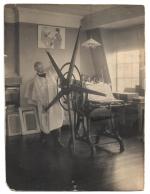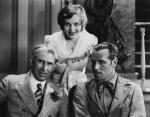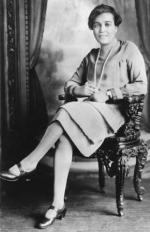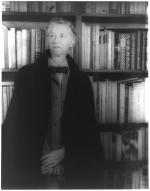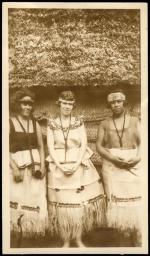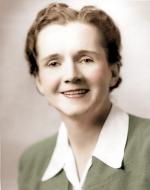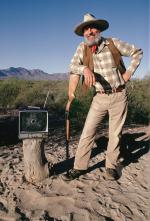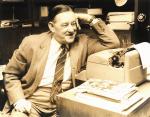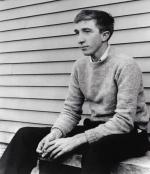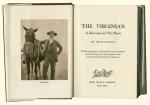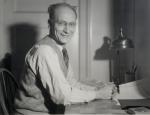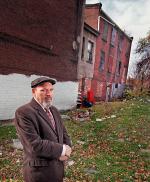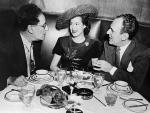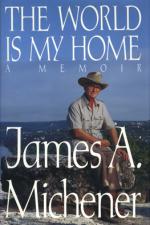Chapter Five: Voices of the Commonwealth: Pennsylvania Writers in the Twentieth Century
In the 1920s, artist Joseph Pennell, who had left his hometown of Philadelphia for a life in London, remarked that "No artist of international reputation...born in Philadelphia has ever been able to live here, or, if he leaves...and returns, the bourgeois by whom the place is entirely overrun drive him out again." What Pennell had to say about Philadelphia also applied to the Commonwealth. The large cities on either edge of the state did offer opportunities for some artists, but greater opportunities and artistic freedom could be found in New York and abroad.
The outside world held deep attractions for young Pennsylvania men and women eager to leave their homes, but in many ways they remained forever attached to them. Such was also the case for many of Pennsylvania's most celebrated poets, playwrights, novelists, and other writers in the twentieth century.
The out-migration from Pennsylvania included young men and women who would become stars in the nation's constellation of literary greats. Some, like Lackawaxen's best-selling Western novelist Zane Grey would leave only after achieving fame and fortune. Most, however, left while still young and unknown. Future Pulitzer Prize-winning poet
Zane Grey would leave only after achieving fame and fortune. Most, however, left while still young and unknown. Future Pulitzer Prize-winning poet  Wallace Stevens, who left public high school in Reading in 1897 for Harvard University, wrote his poetry and literary criticism while working in the insurance business in Hartford, Connecticut.
Wallace Stevens, who left public high school in Reading in 1897 for Harvard University, wrote his poetry and literary criticism while working in the insurance business in Hartford, Connecticut.
In 1915, Stephen Vincent Benét, another future Pulitzer Prize winning poet, left Bethlehem for Yale University and then Paris, where he joined other American expatriates, including F. Scott Fitzgerald and Ernest Hemingway. These writers, later known as the "Lost Generation," would see their story chronicled by another Pennsylvania expat,
Stephen Vincent Benét, another future Pulitzer Prize winning poet, left Bethlehem for Yale University and then Paris, where he joined other American expatriates, including F. Scott Fitzgerald and Ernest Hemingway. These writers, later known as the "Lost Generation," would see their story chronicled by another Pennsylvania expat,  Malcolm Cowley, who had left Pittsburgh for Harvard University in 1915, spent time in Paris, and then settled in New York, where he became a celebrated poet, literary editor, and critic. One of America's most popular historical biographers and writers, David McCullough left Pittsburgh in 1951 for Yale and then New York City. There, McCullough began his career as a historical writer with The Johnstown Flood, a best seller in 1968.
Malcolm Cowley, who had left Pittsburgh for Harvard University in 1915, spent time in Paris, and then settled in New York, where he became a celebrated poet, literary editor, and critic. One of America's most popular historical biographers and writers, David McCullough left Pittsburgh in 1951 for Yale and then New York City. There, McCullough began his career as a historical writer with The Johnstown Flood, a best seller in 1968.
The brain drain, fueled by racism, also shaped the careers of black Pennsylvanians. Enrolling in Cornell after she was refused admission at Bryn Mawr in 1901, Jesse Redmon Fauset then moved to New York City, where she served as literary critic for The Crisis and helped launch the careers of some of the great voices of the Harlem Renaissance. Fauset's literary imagination, however, remained in the city of her childhood. Reflecting her own experiences with culture and as well as race, two of her greatest novels, There is Confusion (1924) and Plum Bun (1929) are set in Philadelphia and New York. In New York, too, Fauset met fellow Philadelphia expatriate
Jesse Redmon Fauset then moved to New York City, where she served as literary critic for The Crisis and helped launch the careers of some of the great voices of the Harlem Renaissance. Fauset's literary imagination, however, remained in the city of her childhood. Reflecting her own experiences with culture and as well as race, two of her greatest novels, There is Confusion (1924) and Plum Bun (1929) are set in Philadelphia and New York. In New York, too, Fauset met fellow Philadelphia expatriate  Alain Locke who in 1925 edited The New Negro, the groundbreaking anthology that featured the work of new generation of modern African American writers coming of age during the 1920s.
Alain Locke who in 1925 edited The New Negro, the groundbreaking anthology that featured the work of new generation of modern African American writers coming of age during the 1920s.
While Locke and Fauset gave voice to modern black America, Margaret Mead helped Americans address their attitudes towards sexuality and the notion of family. The daughter of an economics professor at the University of Pennsylvania, Mead burst upon the national scene in 1926 with publication of Coming of Age in Samoa. She then produced a large body of widely read studies while based for more than fifty years at the American Museum of Natural History in New York.
Margaret Mead helped Americans address their attitudes towards sexuality and the notion of family. The daughter of an economics professor at the University of Pennsylvania, Mead burst upon the national scene in 1926 with publication of Coming of Age in Samoa. She then produced a large body of widely read studies while based for more than fifty years at the American Museum of Natural History in New York.
Not all Pennsylvanians had to go to Harvard or colleges outside the Commonwealth to find their voices and their calling. Popular historian Catherine Drinker Bowen, for example, spent most of her life in the state where she was born and raised. In the early 1900s, Bryn Mawr, one of the nation's finest women's colleges, had a tremendous impact on the lives of many of its students, including
Catherine Drinker Bowen, for example, spent most of her life in the state where she was born and raised. In the early 1900s, Bryn Mawr, one of the nation's finest women's colleges, had a tremendous impact on the lives of many of its students, including  Hanna Doolittle and
Hanna Doolittle and  Marianne Moore. Raised in an academic family in Bethlehem, PA, Doolittle entered Bryn Mawr in 1905 and there met Moore, from Carlisle, and William Carlos Williams and Ezra Pound, both students at the University of Pennsylvania. After graduating from college, Doolittle and Moore would go on to become two of the nation's most celebrated poets, and both Pound-who for a short while was engaged to Doolittle-and Williams, two of the most celebrated writers of the twentieth century.
Marianne Moore. Raised in an academic family in Bethlehem, PA, Doolittle entered Bryn Mawr in 1905 and there met Moore, from Carlisle, and William Carlos Williams and Ezra Pound, both students at the University of Pennsylvania. After graduating from college, Doolittle and Moore would go on to become two of the nation's most celebrated poets, and both Pound-who for a short while was engaged to Doolittle-and Williams, two of the most celebrated writers of the twentieth century.
Some writers found their inspiration in the woods and farmlands of their Pennsylvania childhoods. In 1911, Conrad Richter left the coal country of Schuylkill County first for Cleveland and then for New Mexico, where he wrote seven novels about America's western frontier before moving back to Pine Grove and turning his attention to the history of the older, vanished Pennsylvania frontier and the modern forces that had doomed the rural world of his Pennsylvania childhood.
Conrad Richter left the coal country of Schuylkill County first for Cleveland and then for New Mexico, where he wrote seven novels about America's western frontier before moving back to Pine Grove and turning his attention to the history of the older, vanished Pennsylvania frontier and the modern forces that had doomed the rural world of his Pennsylvania childhood.
Novelist Edward Abbey loved to hike the "big woods" of Indiana County, PA, before he hitchhiked in the 1940s out to the Rocky Mountains and became one of the most popular and cantankerous defenders of the American Southwest. Raised on a farm on the banks of the Ohio River northeast of Pittsburgh,
Edward Abbey loved to hike the "big woods" of Indiana County, PA, before he hitchhiked in the 1940s out to the Rocky Mountains and became one of the most popular and cantankerous defenders of the American Southwest. Raised on a farm on the banks of the Ohio River northeast of Pittsburgh,  Rachel Carson became one of the nation's most popular science writers and author of Silent Spring (1963), the book that helped launched the modern environmental movement.
Rachel Carson became one of the nation's most popular science writers and author of Silent Spring (1963), the book that helped launched the modern environmental movement.
Other writers used their hometowns as their inspiration and the setting for their greatest works. Born in 1905, John O'Hara, in middle decades of the twentieth century wrote a series of popular and award-winning novels and short stories set in "Gibbsville," the fictional stand-in for his hometown of Pottsville and the surrounding communities in Schuylkill County coal country. Born in Reading, and raised in nearby Shillington and Plowville, John Updike left for Harvard University in 1950, and remained in Massachusetts. Updike, however, would base many of his most popular and critically acclaimed novels and short stories in Berks County, a place he called America's "doughy middle." "I loved Shillington," he would write in 1989, "not as one loves Capri or New York, because they are special, but as one loves one's own body and consciousness, because they are synonymous with being.... If there was a meaning to existence, I was closest to it here."
John O'Hara, in middle decades of the twentieth century wrote a series of popular and award-winning novels and short stories set in "Gibbsville," the fictional stand-in for his hometown of Pottsville and the surrounding communities in Schuylkill County coal country. Born in Reading, and raised in nearby Shillington and Plowville, John Updike left for Harvard University in 1950, and remained in Massachusetts. Updike, however, would base many of his most popular and critically acclaimed novels and short stories in Berks County, a place he called America's "doughy middle." "I loved Shillington," he would write in 1989, "not as one loves Capri or New York, because they are special, but as one loves one's own body and consciousness, because they are synonymous with being.... If there was a meaning to existence, I was closest to it here."
In the early 1900s, Philadelphia produced only one writer of national acclaim, Owen Wister, who made his reputation by writing the first great western, The Virginian. Yet the "City of Brotherly Love," as Philadelphia is still called, also provided ample raw material for eager writers. In the early 1900s Philadelphia genre works were created by native Philadelphians like Francis Biddle, Joseph Hergesheimer, and George Kelly, who won the 1925 Pulitzer Prize for his play, Craig's Wife; and by non-natives, such as Christopher Morley, Struthers Burt, and Philip Barry, whose The Philadelphia Story, published in 1939, became the 1940 Academy Award-winning film starring Indiana, Pennsylvania's
Owen Wister, who made his reputation by writing the first great western, The Virginian. Yet the "City of Brotherly Love," as Philadelphia is still called, also provided ample raw material for eager writers. In the early 1900s Philadelphia genre works were created by native Philadelphians like Francis Biddle, Joseph Hergesheimer, and George Kelly, who won the 1925 Pulitzer Prize for his play, Craig's Wife; and by non-natives, such as Christopher Morley, Struthers Burt, and Philip Barry, whose The Philadelphia Story, published in 1939, became the 1940 Academy Award-winning film starring Indiana, Pennsylvania's  Jimmy Stewart and Bryn Mawr graduate Katharine Hepburn. In 1939, labor organizer William Z. Foster's Pages From a Worker's Life provided readers a very different view of Philadelphia: a harrowing glimpse into the city's workplaces.
Jimmy Stewart and Bryn Mawr graduate Katharine Hepburn. In 1939, labor organizer William Z. Foster's Pages From a Worker's Life provided readers a very different view of Philadelphia: a harrowing glimpse into the city's workplaces.
Pittsburgh, too, had its chroniclers. Judge Michael Mussmanno fictionalized account of the murder of coal miner John Barkoski during the 1927 coal strike became a Hollywood film, Black Fury, in 1935, and a novel of the same name published in 1966. The son of Rusyn immigrants who father worked as coal miner, Thomas Bell (born Adalbert Thomas Belejcak) left Pittsburgh to become a writer in New York. Later in life, Bell wrote Out Of This Furnace: A Novel of Immigrant Labor in America (1941), a powerful and moving novel about the lives of three generations of "Slovaks" who labored in the Edgar Thomson Steel Works, because "my conscience dictated me to write." Between the early 1980s and 2005, playwright
Judge Michael Mussmanno fictionalized account of the murder of coal miner John Barkoski during the 1927 coal strike became a Hollywood film, Black Fury, in 1935, and a novel of the same name published in 1966. The son of Rusyn immigrants who father worked as coal miner, Thomas Bell (born Adalbert Thomas Belejcak) left Pittsburgh to become a writer in New York. Later in life, Bell wrote Out Of This Furnace: A Novel of Immigrant Labor in America (1941), a powerful and moving novel about the lives of three generations of "Slovaks" who labored in the Edgar Thomson Steel Works, because "my conscience dictated me to write." Between the early 1980s and 2005, playwright  August Wilson set his celebrated cycle of ten plays, which provide a decade-by-decade chronicle of African-American life and struggle, in his hometown of Pittsburgh.
August Wilson set his celebrated cycle of ten plays, which provide a decade-by-decade chronicle of African-American life and struggle, in his hometown of Pittsburgh.
Not all of the movement of literary talent took place from inside to outside the state. In the 1930s, the rural and very affordable land of Bucks County attracted New Yorkers, including Josephine Herbst, S.J. Perelman and his brother-in-law Nathaniel West, wit and journalist Dorothy Parker, and screenwriters George S. Kaufman and Moss Hart, whose misadventures in country living led to their collaboration on George Washington Slept Here, the play that gave inspiration to the television program Green Acres.
A Doylestown native, James Michener wrote sweeping narratives, both historical and fictional, of frontiers ranging from Afghanistan, Colorado, and South Africa to the American space program. In the late 1940s, Michener would help Bucks County newcomer
James Michener wrote sweeping narratives, both historical and fictional, of frontiers ranging from Afghanistan, Colorado, and South Africa to the American space program. In the late 1940s, Michener would help Bucks County newcomer  Oscar Hammerstein, Jr. turn his Pulitzer Prize-winning Tales of the South Pacific into the Broadway musical South Pacific. Both were friends with Nobel-prize winning author
Oscar Hammerstein, Jr. turn his Pulitzer Prize-winning Tales of the South Pacific into the Broadway musical South Pacific. Both were friends with Nobel-prize winning author  Pearl Buck, who had moved to Bucks County in 1935. African-American writer Jean Toomer, another New Yorker, lived in Doylestown from 1936 until his death in 1967.
Pearl Buck, who had moved to Bucks County in 1935. African-American writer Jean Toomer, another New Yorker, lived in Doylestown from 1936 until his death in 1967.
From the late 1900s to the present, more and more writers, poets, playwrights, journalists, scientists, scholars, public servants, and other wordsmiths have made Pennsylvania their home, and used its people, landscapes, and history as the inspiration for and the subject of their work. Philadelphia-based novels, as just one example, include Jack Dunphy's John Fury (1946), David Bradley's South Street (1975) and The Chaneysville Incident (1981), and John Edgar Wideman's Philadelphia Fire (1990). In 2003, the city-wide One Book, One Philadelphia project chose Lorene Cary's Price of a Child (1995), the story of a young women who flees Virginia for Philadelphia on the Underground Railroad, as its first selection in an annual event that promotes reading, literacy, and libraries.
To learn more about the recent history of Pennsylvania's writers and publishers, ExplorePAhistory.com encourages you to continue your own reading elsewhere. Since Pennsylvania only dedicates state historical markers for people who are deceased, the living history of Pennsylvania's writers and publishers is all around us.
The outside world held deep attractions for young Pennsylvania men and women eager to leave their homes, but in many ways they remained forever attached to them. Such was also the case for many of Pennsylvania's most celebrated poets, playwrights, novelists, and other writers in the twentieth century.
The out-migration from Pennsylvania included young men and women who would become stars in the nation's constellation of literary greats. Some, like Lackawaxen's best-selling Western novelist
In 1915,
The brain drain, fueled by racism, also shaped the careers of black Pennsylvanians. Enrolling in Cornell after she was refused admission at Bryn Mawr in 1901,
While Locke and Fauset gave voice to modern black America,
Not all Pennsylvanians had to go to Harvard or colleges outside the Commonwealth to find their voices and their calling. Popular historian
Some writers found their inspiration in the woods and farmlands of their Pennsylvania childhoods. In 1911,
Novelist
Other writers used their hometowns as their inspiration and the setting for their greatest works. Born in 1905,
In the early 1900s, Philadelphia produced only one writer of national acclaim,
Pittsburgh, too, had its chroniclers.
Not all of the movement of literary talent took place from inside to outside the state. In the 1930s, the rural and very affordable land of Bucks County attracted New Yorkers, including Josephine Herbst, S.J. Perelman and his brother-in-law Nathaniel West, wit and journalist Dorothy Parker, and screenwriters George S. Kaufman and Moss Hart, whose misadventures in country living led to their collaboration on George Washington Slept Here, the play that gave inspiration to the television program Green Acres.
A Doylestown native,
From the late 1900s to the present, more and more writers, poets, playwrights, journalists, scientists, scholars, public servants, and other wordsmiths have made Pennsylvania their home, and used its people, landscapes, and history as the inspiration for and the subject of their work. Philadelphia-based novels, as just one example, include Jack Dunphy's John Fury (1946), David Bradley's South Street (1975) and The Chaneysville Incident (1981), and John Edgar Wideman's Philadelphia Fire (1990). In 2003, the city-wide One Book, One Philadelphia project chose Lorene Cary's Price of a Child (1995), the story of a young women who flees Virginia for Philadelphia on the Underground Railroad, as its first selection in an annual event that promotes reading, literacy, and libraries.
To learn more about the recent history of Pennsylvania's writers and publishers, ExplorePAhistory.com encourages you to continue your own reading elsewhere. Since Pennsylvania only dedicates state historical markers for people who are deceased, the living history of Pennsylvania's writers and publishers is all around us.





